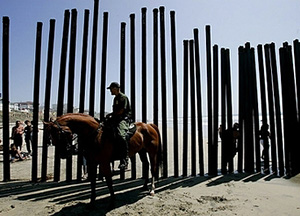 |
 |
 |
 Editorials | At Issue | October 2006 Editorials | At Issue | October 2006  
Experts See U.S. Border Fence Plan as Impractical
 Tim Gaynor - Reuters Tim Gaynor - Reuters


| | A mounted border police officer patrols the US-MExico border in California, in August 2006. As the political rhetoric heats up in the United States over illegal immigration, a crackdown on immigrants convicted of even minor crimes has led to a massive increase in federal prosecutions and deportations of immigrants in the United States over the past 10 years. (AFP/Sandy Huffaker) |
Building a fence to try to secure the U.S. border with Mexico is impractical and would simply lead illegal immigrants to cross elsewhere, according to former Customs and Border Protection agents and other experts.

The Senate voted on Friday to build about 700 miles (1,125 km) of double-layered fence with access roads, lighting, cameras and sensors, to try to block five heavily used crossing points along the 2,000-mile (3,200-km) border.

The plan includes a sweep of fencing along most of the Arizona border, where about half of the almost 1.2 million people nabbed crossing from Mexico last year were arrested.

The fence would also stretch through parts of California, New Mexico and Texas.

Former U.S. Customs agents who have hunted drug traffickers in the mountains and deserts of around the Arizona border said the new barrier would be defeated by the rugged terrain.

"You can't build a wall across the mountains of southern Arizona, as much of the terrain is inaccessible even on foot," veteran agent Lee Morgan told Reuters as he stood near the proposed route of the fence, east of the town of Douglas.

INACCESSIBLE AREA

The barrier would have to traverse the rugged Huachuca mountains and other craggy ranges west of Nogales, Arizona, which are marked by bluffs and ravines that make them inaccessible to vehicle traffic, Morgan noted.

Another former U.S. Customs special agent, who declined to be named, said the fencing would also struggle to bridge hundreds of creek beds spanning the Arizona-Sonora border, which are prone to flash floods from May through October.

"You are going to have to build hundreds of culverts big enough for debris the size of brush and small trees to float through the length of the border," said the former agent.

"If it is wide enough for bushes to get through, then people can get through."

The Senate gave final approval to the Secure Fence Act on Friday and sent it to President George W. Bush to sign into law, in the hope that it will showcase Republicans' efforts to stop illegal immigration before November 7 congressional elections.

Republican backers of the proposal contend it is necessary to prevent entry to the United States by illegal immigrants and extremists, and to prevent weapons and drug smuggling.

But analysts warned it would have a limited impact on security.

"It may work to curtail crossings in the immediate area it has been built, but it won't stop illegal immigration," said Doris Meissner, senior fellow at the Migration Policy Institute in Washington.

"Experience has shown that traffic will shift to other parts of the border" where there is less vigilance, added Meissner, a former commissioner at the now defunct U.S. Immigration and Naturalization Service.

She cited previous policing operations in the 1990s which secured heavily crossed urban stretches of the border in El Paso, Texas, and San Diego, California, but drove determined migrants out into remote desert areas to cross.

"The draw for illegal immigrants is the availability of employment in the United States, and that is not being addressed by this fence," she said. | 
 | |
 |



